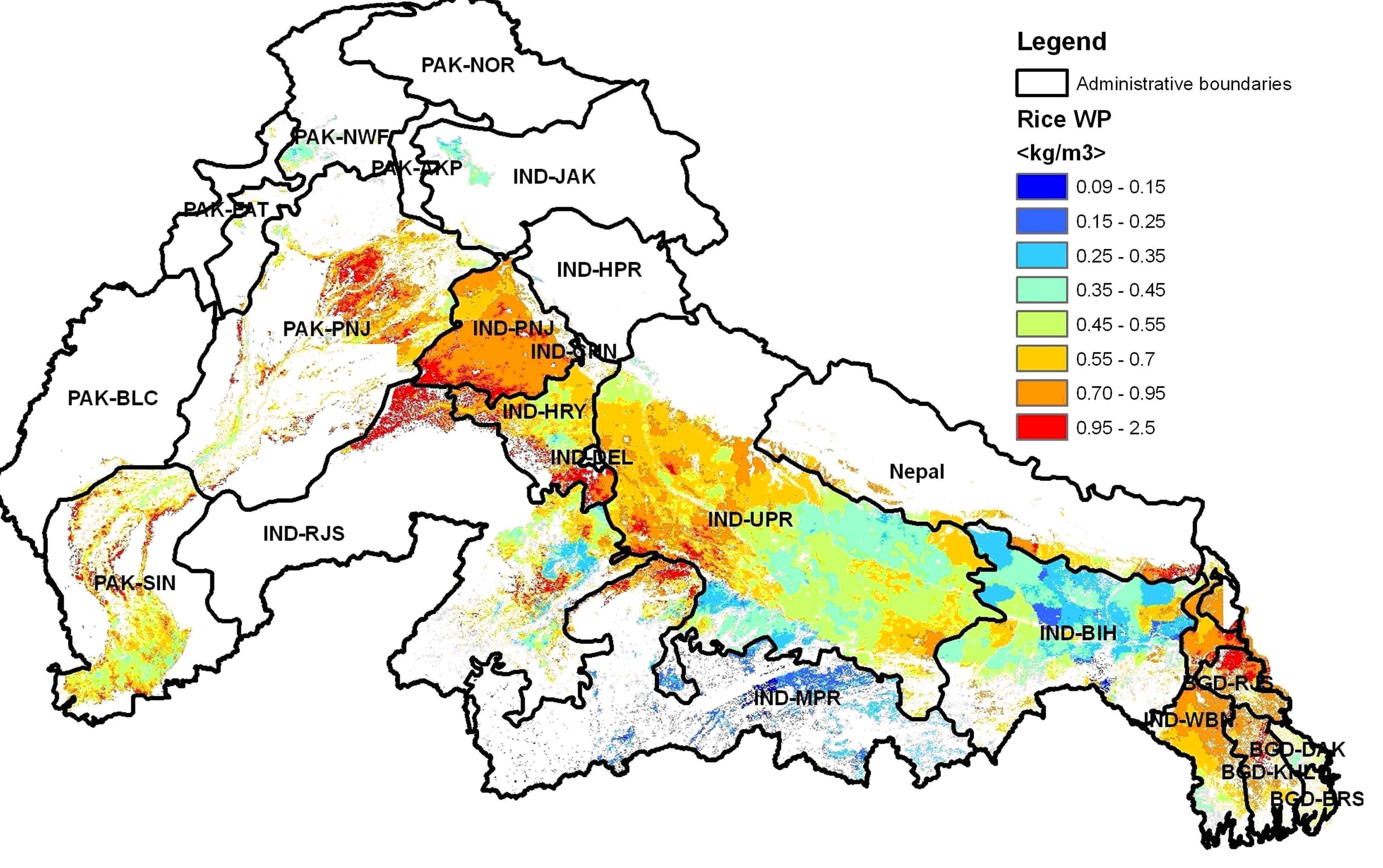The Indo-Ganges Basin Focal Project is conducting a basin-wide analysis of the conditions, constraints and opportunities for improving agricultural water productivity and alleviating poverty through high potential interventions. The project is organized in six work packages: water poverty analysis (WP1), water availability analysis (WP2), water productivity analysis (WP3), institutional analysis (WP4), intervention analysis (WP5) and knowledge base development (WP6). Some of the key emerging insights below:
Poverty: Analysis exhibits the dynamics of water, land and poverty nexus in Indo-Ganges (IG) basin and how they are likely to evolve in future. High population growth in the riparian countries acts as a significant driver of depleting and degrading the natural resources in the IGB. Head Count Ratio (HCR), a measure of poverty, is found to have improved significantly in the recent years. The incidence of poverty in India has declined from 50% in the mid ‘70s to about 21% (population below the poverty line) in In Pakistan, even though slight increase in HCR was noticed in the later half of 1990’s, it has declined thereafter. The depth and severity of poverty in all demographic groups in the four riparian countries have declined over the last decade. Yet, income of a large part of the poor population is still well below the poverty line. Poverty maps developed show high variations in poverty across IGB.
The HCR is relatively lower in north and north-western parts of IGB, which mainly includes northern part of Pakistan Punjab and Indian Punjab, parts of Rajasthan in the Indus basin and Haryana and the western parts of Uttar Pradesh of India, and Kathmandu region in Nepal in the Ganga basin. In Nepal, low poverty regions are concentrated in urban centers. The HCR is high in the southern and eastern parts of IGB, consisting of states of Bihar, Chattisgarh, Jharkand, and western part of Uttar Pradesh, and Madhya Pradesh in India; southern Punjab, North West Frontier (NWFP), Sindh, and Baluchistan provinces in Pakistan; south-west divisions of Bangladesh; and all NLSS regions except Kathmandu in Nepal. Focus of poverty alleviation in rural areas can have a significant impact in the overall poverty of the whole basin. Read More.....
Water availability:
This work package assesses water balance components in the basin, impact of climate change and upstream land use changes on water availability. The following observations were made from land-use maps of Gorai sub-basin between 1977 and 1997.
- 2% reduction in water bodies from 1977 to 1997
- Settlement area remains constant
- Agriculture area including rice has increased from 52% to 80% from the total area land extent.
- Forest area has decreased from 29% to 4%
- Inflows have reduced in the Gorai River Catchment due to Farakka Barrage in India
- Simulations from the downstream or the outlet of the basin shows that flows are reduced during the monsoon season, however, flows in the dry season, esp. March-May has not changed in the two periods and is affected by the land use in the whole basin
- Outlet of the catchment is affected by land use within the catchment as well as inflow coming from the Ganges
- Land use changes within the Gorai River Catchment can significantly increase flows, providing more freshwater flow into the Sundarban mangrove forests.
Water productivity:
Water productivity is generally low and there is great scope for improvement. Significant variability exists across fields and regions. A general decline from from North-West to South-East is observed. However, the variability shows no direct relationship with climate condition, indicating the importance of irrigation. Sugarcane, pulses and millet make significant contributions to the overall water productivity. The average estimated rice water productivity of the basin is 0.618 kg/m3. The map (Fig. 1) below shows huge spatial variation indicating scope for improvement. Read More...

Fig. 1. Average rice water productivity in the Indo-Ganges basin for the year 2005
Institutional analysis:
Analysis is focussed on institutions with a broad view of encompassing water-related policies, laws and administrative structure as well as informal water institutions such as water user organisations, water markets and civil society organisations working in the water resource sector.
Impact of rising diesel prices: IGB is experiencing rising costs of agricultural water use in ways that have positive water productivity impacts and adverse livelihood impacts. For example, high surrogate water price is driving out smallholder irrigation. Electricity supply to the farm sector-which is subsidized in much of Peninsular India is dwindling in the IGB and is increasingly unreliable. Irrigation expansion in the basin is now occuring through increase in numbers of diesel pumps. The major challenge now is to find ways of bringing down agricultural water use cost below the 'upper threshold' beyond which abundantly available water becomes too expensive for the poor to use to maintain livelihoods and food security.
Water control and land-lease markets in Nepal:Leasehold practices in Nepal shows that fedual characteristics of land-holding has perpetuated wide gaps between the rich and poor in the rural areas, affecting tenancy practices.
- Three forms of tenancy practices were found- mortgage, share crop and contract [Hunda in terai]. Mortgage and share crop are the widely popular form of tenancy in the hills. Whereas, Share crop and Hunda are the preferred form of leasehold in terai. The intensity of leasehold in terai is higher than in the hills and inner terai.
- Electrice operated shallow tubewell irrigated land is preferred by the contractor for lease than the surface and diesel operated shallow tubewell. This indicates that availability of assured irrigation and cost effectiveness is the first priority of the lessee.
Intervention analysis:
Some early insights on intervention analysis are
- Sugarcane and mustard in cropping system could enhance water productivity in the IGB.
- Irrigation scheduling is found to be the potential intervention for crops like rice, wheat, tomato and sugarcane.
- For maize and oilseeds, use of hybrid seeds holds potential.
- Use of quality seeds is critial for many crops like, potato.
Comments (0)
You don't have permission to comment on this page.